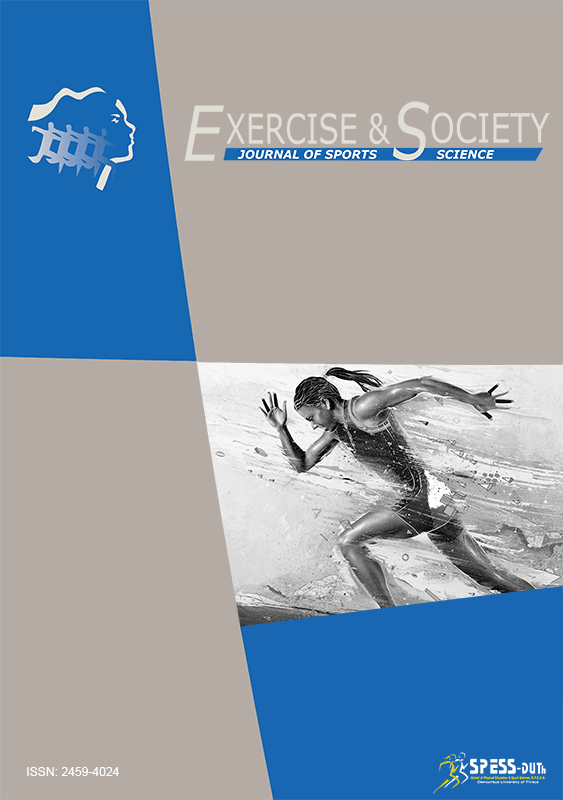Did the COVID-19 pandemic period change exercise habits, intentions, and expectations in terms of exercising?
Abstract
One of the restrictive measures that was undertaken by many governments globally during the COVID-19 pandemic was the suspension of gyms and athletic centers during the quarantine. The aim of the present study was to record if the COVID-19 pandemic period changed exercise habits, intentions, and expectations in terms of exercising of persons living in Greece. An electronic questionnaire was created that contained questions in relation to exercise behavior before the closure of the gyms, during their brief reopening and during the two quarantines. In the research participated 1203 persons. The majority of the participants continued to work out during the lockdown. However, due to the pandemic, they substituted their usual ways of working out with new forms of exercise (e.g. unsupervised exercise at home, internet-based exercise etc.). The new experiences that the exercisers accumulated during the lockdown created new needs regarding their preferences in relation to exercise. For this reason, although they expressed their intention to return to the gyms after their reopening, they also made some proposals regarding desirable new services, that should be taken into account from the part of the professionals working at the fitness industry in order to respond effectively to the new needs.
References
Castañeda-Babarro, A., Coca, A., Arbillaga-Etxarri, A., & Gutiérrez-Santamaría, B. (2020). Physical activity change during COVID-19 confinement. International Journal of Environmental Research and Public Health, 17(18), 1–10.
Desimone, G. T. (2020). Shareable Resource: Virtual Fitness: Choosing A Program That Is Right for You. ACSM’s Health and Fitness Journal, 24(4), 3–4.
Eysenbach G. (2004). Improving the quality of Web surveys: the Checklist for Reporting Results of Internet E-Surveys (CHERRIES). Journal of medical Internet research, 6(3), e34.
Fitbit, Inc. The Impact of Coronavirus on Global Activity (Online). https://blog.fitbit.com/covid-19-global-activity/ (τελευταία προσπέλαση 5 Φεβρουαρίου 2021)
Godefroy, J. (2020). Recommending Physical Activity During the COVID-19 Health Crisis. Fitness Influencers on Instagram. Frontiers in Sports and Active Living, 2(December), 1–7.
Κλεισούρας, Β., Γελαδάς, Ν., Κοσκολού, Μ. (2015). Εργομετρία. Broken Hill Publishers LTD: Cyprus
Lesser, I. A., & Nienhuis, C. P. (2020). The impact of COVID-19 on physical activity behavior and well-being of canadians. International Journal of Environmental Research and Public Health, 17(11).
Malliou, P., Rokka, S., Beneka, A., Gioftsidou, A., Mavromoustakos, S., & Godolias, G. (2014). Analysis of the chronic lower limb injuries occurrence in step aerobic instructors in relation to their working step class profile: A three-year longitudinal prospective study. Journal of Back and Musculoskeletal Rehabilitation, 27(3), 361–370.
Ουζούνη, Χ. & Νακάκης, Κ. (2011). Η Αξιοπιστία και η Εγκυρότητα των Εργαλείων Μέτρησης σε Ποσοτικές Μελέτες. Νοσηλευτική, 50(2), 231-239.
Pecanha, T., Goessler, K. F., Roschel, H., & Gualano, B. (2020). Social isolation during the COVID-19 pandemic can increase physical inactivity and the global burden of cardiovascular disease. American Journal of Physiology - Heart and Circulatory Physiology, 318(6), H1441–H1446.
Rodríguez, M., Crespo, I., & Olmedillas, H. (2020). Exercising in times of COVID-19: what do experts recommend doing within four walls? Rev Esp Cardiol, 73(7), 527–529.
Sahu, A., & Naqvi, W. M. (2020). Quarantine Exercises in the Time of Covid-19- A Review. Journal of Evolution of Medical and Dental Sciences, 9(26), 1922–1927.
Sayed, M. A., Walsh, K., & Sheikh, Z. (2020). COVID-19 and the rise of the full 'Fitness' friction burn. Burns: journal of the International Society for Burn Injuries, 46(7), 1717.
Sowier-kasprzyk, I., & Widawska-stanisz, A. (2020). Original Article Changes in attitudes of consumers of sports and recreational services in the context of Covid-19, 20(5), 2939–2944.
Thompson, W. R. (2021). Worldwide Survey of Fitness Trends for 2021. ACSM’s Health and Fitness Journal, 25(1), 10–19.
Zheng, C., Huang, W. Y., Sheridan, S., Sit, C. H. P., Chen, X. K., & Wong, S. H. S. (2020). COVID-19 pandemic brings a sedentary lifestyle: A cross-sectional and longitudinal study. MedRxiv, (March 2020).
Downloads
Published
How to Cite
Issue
Section
License
Authors who publish with this journal agree to the following terms:
a. Authors retain copyright and grant the journal right of first publication with the work simultaneously licensed under a Creative Commons Attribution License that allows others to share the work with an acknowledgement of the work's authorship and initial publication in this journal.
b. Authors are able to enter into separate, additional contractual arrangements for the non-exclusive distribution of the journal's published version of the work (e.g., post it to an institutional repository or publish it in a book), with an acknowledgement of its initial publication in this journal.
c. Authors are permitted and encouraged to post their work online (e.g., in institutional repositories or on their website) prior to and during the submission process, as it can lead to productive exchanges, as well as earlier and greater citation of published work (See The Effect of Open Access).


